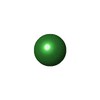+ Open data
Open data
- Basic information
Basic information
| Entry | Database: PDB / ID: 2c2l | ||||||
|---|---|---|---|---|---|---|---|
| Title | Crystal structure of the CHIP U-box E3 ubiquitin ligase | ||||||
 Components Components |
| ||||||
 Keywords Keywords | CHAPERONE / E3 LIGASE / UBIQUITINYLATION / TPR / HEAT-SHOCK PROTEIN COMPLEX | ||||||
| Function / homology |  Function and homology information Function and homology informationpositive regulation of chaperone-mediated protein complex assembly / Downregulation of TGF-beta receptor signaling / regulation of glucocorticoid metabolic process / Downregulation of ERBB2 signaling / negative regulation of vascular associated smooth muscle contraction / Regulation of TNFR1 signaling / negative regulation of peroxisome proliferator activated receptor signaling pathway / Regulation of PTEN stability and activity / Regulation of RUNX2 expression and activity / Regulation of necroptotic cell death ...positive regulation of chaperone-mediated protein complex assembly / Downregulation of TGF-beta receptor signaling / regulation of glucocorticoid metabolic process / Downregulation of ERBB2 signaling / negative regulation of vascular associated smooth muscle contraction / Regulation of TNFR1 signaling / negative regulation of peroxisome proliferator activated receptor signaling pathway / Regulation of PTEN stability and activity / Regulation of RUNX2 expression and activity / Regulation of necroptotic cell death / ubiquitin conjugating enzyme complex / positive regulation of ERAD pathway / positive regulation of smooth muscle cell apoptotic process / positive regulation of mitophagy / negative regulation of cardiac muscle hypertrophy / nuclear inclusion body / misfolded protein binding / Antigen processing: Ubiquitination & Proteasome degradation / cellular response to misfolded protein / protein folding chaperone complex / sperm mitochondrial sheath / sulfonylurea receptor binding / positive regulation of ubiquitin-protein transferase activity / ubiquitin-ubiquitin ligase activity / dATP binding / CTP binding / positive regulation of protein polymerization / Scavenging by Class F Receptors / vRNP Assembly / UTP binding / chaperone-mediated autophagy / sperm plasma membrane / Rho GDP-dissociation inhibitor binding / Respiratory syncytial virus genome replication / telomerase holoenzyme complex assembly / mitochondrial transport / Uptake and function of diphtheria toxin / Drug-mediated inhibition of ERBB2 signaling / Resistance of ERBB2 KD mutants to trastuzumab / Resistance of ERBB2 KD mutants to sapitinib / Resistance of ERBB2 KD mutants to tesevatinib / Resistance of ERBB2 KD mutants to neratinib / Resistance of ERBB2 KD mutants to osimertinib / Resistance of ERBB2 KD mutants to afatinib / Resistance of ERBB2 KD mutants to AEE788 / Resistance of ERBB2 KD mutants to lapatinib / Drug resistance in ERBB2 TMD/JMD mutants / protein import into mitochondrial matrix / dendritic growth cone / TPR domain binding / PIWI-interacting RNA (piRNA) biogenesis / Assembly and release of respiratory syncytial virus (RSV) virions / negative regulation of smooth muscle cell apoptotic process / non-chaperonin molecular chaperone ATPase / protein quality control for misfolded or incompletely synthesized proteins / R-SMAD binding / positive regulation of proteolysis / protein unfolding / Sema3A PAK dependent Axon repulsion / regulation of protein ubiquitination / protein K63-linked ubiquitination / positive regulation of cell size / HSF1-dependent transactivation / protein monoubiquitination / enzyme-substrate adaptor activity / response to unfolded protein / ubiquitin ligase complex / regulation of protein-containing complex assembly / skeletal muscle contraction / HSF1 activation / Attenuation phase / neurofibrillary tangle assembly / chaperone-mediated protein complex assembly / RHOBTB2 GTPase cycle / regulation of postsynaptic membrane neurotransmitter receptor levels / telomere maintenance via telomerase / axonal growth cone / endoplasmic reticulum unfolded protein response / protein autoubiquitination / positive regulation of lamellipodium assembly / negative regulation of protein binding / nitric oxide metabolic process / eNOS activation / DNA polymerase binding / response to salt stress / heat shock protein binding / ERAD pathway / positive regulation of defense response to virus by host / Tetrahydrobiopterin (BH4) synthesis, recycling, salvage and regulation / positive regulation of telomere maintenance via telomerase / Signaling by ERBB2 / cardiac muscle cell apoptotic process / endocytic vesicle lumen / positive regulation of cardiac muscle contraction / Loss of Nlp from mitotic centrosomes / Loss of proteins required for interphase microtubule organization from the centrosome / Recruitment of mitotic centrosome proteins and complexes / Hsp70 protein binding / lysosomal lumen / Recruitment of NuMA to mitotic centrosomes Similarity search - Function | ||||||
| Biological species |   HOMO SAPIENS (human) HOMO SAPIENS (human) | ||||||
| Method |  X-RAY DIFFRACTION / X-RAY DIFFRACTION /  SYNCHROTRON / SYNCHROTRON /  MOLECULAR REPLACEMENT / Resolution: 3.3 Å MOLECULAR REPLACEMENT / Resolution: 3.3 Å | ||||||
 Authors Authors | Zhang, M. / Roe, S.M. / Pearl, L.H. | ||||||
 Citation Citation |  Journal: Mol.Cell / Year: 2005 Journal: Mol.Cell / Year: 2005Title: Chaperoned Ubiquitylation-Crystal Structures of the Chip U Box E3 Ubiquitin Ligase and a Chip-Ubc13-Uev1A Complex Authors: Zhang, M. / Windheim, M. / Roe, S.M. / Peggie, M. / Cohen, P. / Prodromou, C. / Pearl, L.H. | ||||||
| History |
|
- Structure visualization
Structure visualization
| Structure viewer | Molecule:  Molmil Molmil Jmol/JSmol Jmol/JSmol |
|---|
- Downloads & links
Downloads & links
- Download
Download
| PDBx/mmCIF format |  2c2l.cif.gz 2c2l.cif.gz | 239.4 KB | Display |  PDBx/mmCIF format PDBx/mmCIF format |
|---|---|---|---|---|
| PDB format |  pdb2c2l.ent.gz pdb2c2l.ent.gz | 195.6 KB | Display |  PDB format PDB format |
| PDBx/mmJSON format |  2c2l.json.gz 2c2l.json.gz | Tree view |  PDBx/mmJSON format PDBx/mmJSON format | |
| Others |  Other downloads Other downloads |
-Validation report
| Arichive directory |  https://data.pdbj.org/pub/pdb/validation_reports/c2/2c2l https://data.pdbj.org/pub/pdb/validation_reports/c2/2c2l ftp://data.pdbj.org/pub/pdb/validation_reports/c2/2c2l ftp://data.pdbj.org/pub/pdb/validation_reports/c2/2c2l | HTTPS FTP |
|---|
-Related structure data
- Links
Links
- Assembly
Assembly
| Deposited unit | 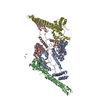
| ||||||||||||
|---|---|---|---|---|---|---|---|---|---|---|---|---|---|
| 1 | 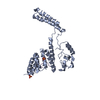
| ||||||||||||
| 2 | 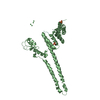
| ||||||||||||
| 3 | 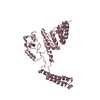
| ||||||||||||
| 4 | 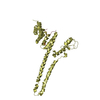
| ||||||||||||
| Unit cell |
| ||||||||||||
| Noncrystallographic symmetry (NCS) | NCS oper:
|
- Components
Components
| #1: Protein | Mass: 32728.904 Da / Num. of mol.: 4 Source method: isolated from a genetically manipulated source Source: (gene. exp.)   #2: Protein/peptide | Mass: 1082.120 Da / Num. of mol.: 4 / Fragment: C-TERMINAL PEPTIDE, UNP RESIDUES 414-422 / Source method: obtained synthetically / Source: (synth.)  HOMO SAPIENS (human) / References: UniProt: Q96HX7, UniProt: P07900*PLUS HOMO SAPIENS (human) / References: UniProt: Q96HX7, UniProt: P07900*PLUS#3: Chemical | ChemComp-SO4 / #4: Chemical | ChemComp-NI / #5: Water | ChemComp-HOH / | |
|---|
-Experimental details
-Experiment
| Experiment | Method:  X-RAY DIFFRACTION / Number of used crystals: 1 X-RAY DIFFRACTION / Number of used crystals: 1 |
|---|
- Sample preparation
Sample preparation
| Crystal | Density Matthews: 4.4 Å3/Da / Density % sol: 71.5 % |
|---|---|
| Crystal grow | Temperature: 293 K / Method: vapor diffusion / pH: 7.5 Details: MCHIP WAS MIXED WITH HUMAN HSP90 C-TERMINAL PEPTIDE AT A 1:3 MOLAR RATIO, RESPECTIVELY, INCUBATED FOR 30 MIN AT 4C AND CONCENTRATED TO 10 MG/ML. INITIAL MULTIPLE CRYSTALS WERE GROWN BY ...Details: MCHIP WAS MIXED WITH HUMAN HSP90 C-TERMINAL PEPTIDE AT A 1:3 MOLAR RATIO, RESPECTIVELY, INCUBATED FOR 30 MIN AT 4C AND CONCENTRATED TO 10 MG/ML. INITIAL MULTIPLE CRYSTALS WERE GROWN BY VAPOUR DIFFUSION AT 20C AGAINST 30% W/V PEG4000, 100 MM TRIS [PH 7.5] AND 200 MM LITHIUM SULPHATE. SUBSEQUENT STREAK-SEEDING INTO SOLUTIONS OF 16% W/V PEG4000, 100 MM TRIS [PH 7.5] AND 400 MM LITHIUM SULPHATE PRODUCED SINGLE PLATES. |
-Data collection
| Diffraction | Mean temperature: 100 K |
|---|---|
| Diffraction source | Source:  SYNCHROTRON / Site: SYNCHROTRON / Site:  ESRF ESRF  / Beamline: ID23-1 / Wavelength: 0.9801 / Beamline: ID23-1 / Wavelength: 0.9801 |
| Detector | Type: MARRESEARCH / Detector: CCD / Date: Mar 17, 2005 |
| Radiation | Protocol: SINGLE WAVELENGTH / Monochromatic (M) / Laue (L): M / Scattering type: x-ray |
| Radiation wavelength | Wavelength: 0.9801 Å / Relative weight: 1 |
| Reflection | Resolution: 3.3→40 Å / Num. obs: 68272 / % possible obs: 98.1 % / Observed criterion σ(I): 0 / Redundancy: 2.1 % / Biso Wilson estimate: 84.6 Å2 / Rmerge(I) obs: 0.07 / Net I/σ(I): 10 |
| Reflection shell | Resolution: 3.3→3.47 Å / Redundancy: 2.1 % / Rmerge(I) obs: 0.33 / Mean I/σ(I) obs: 2.7 / % possible all: 98.1 |
- Processing
Processing
| Software |
| ||||||||||||||||||||||||||||||||||||||||||||||||||||||||||||
|---|---|---|---|---|---|---|---|---|---|---|---|---|---|---|---|---|---|---|---|---|---|---|---|---|---|---|---|---|---|---|---|---|---|---|---|---|---|---|---|---|---|---|---|---|---|---|---|---|---|---|---|---|---|---|---|---|---|---|---|---|---|
| Refinement | Method to determine structure:  MOLECULAR REPLACEMENT MOLECULAR REPLACEMENTStarting model: IN-HOUSE MODEL Resolution: 3.3→40 Å / Data cutoff high absF: 10000 / Cross valid method: THROUGHOUT / σ(F): 0 / Stereochemistry target values: MAXIMUM LIKELIHOOD
| ||||||||||||||||||||||||||||||||||||||||||||||||||||||||||||
| Solvent computation | Solvent model: FLAT / Bsol: 14.9172 Å2 / ksol: 0.307367 e/Å3 | ||||||||||||||||||||||||||||||||||||||||||||||||||||||||||||
| Displacement parameters | Biso mean: 80.1 Å2
| ||||||||||||||||||||||||||||||||||||||||||||||||||||||||||||
| Refinement step | Cycle: LAST / Resolution: 3.3→40 Å
| ||||||||||||||||||||||||||||||||||||||||||||||||||||||||||||
| Refine LS restraints |
| ||||||||||||||||||||||||||||||||||||||||||||||||||||||||||||
| LS refinement shell | Resolution: 3.3→3.49 Å / Total num. of bins used: 7
| ||||||||||||||||||||||||||||||||||||||||||||||||||||||||||||
| Xplor file |
|
 Movie
Movie Controller
Controller



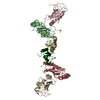
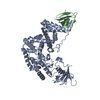
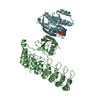
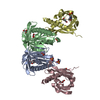
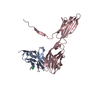

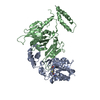
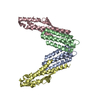
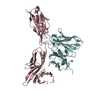
 PDBj
PDBj
























